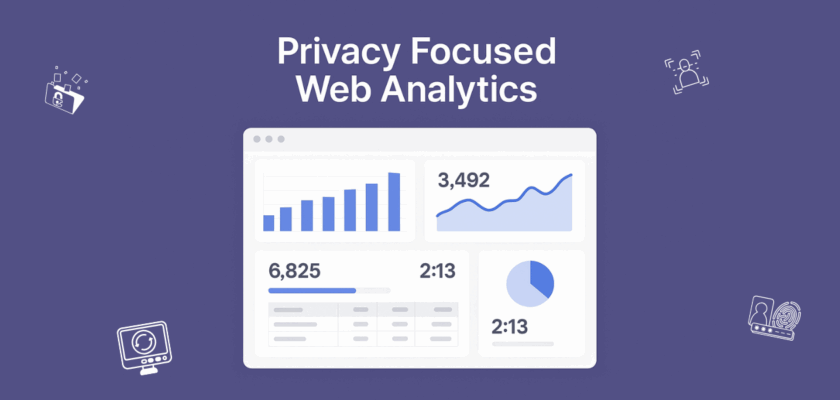In a world where websites quietly collect every scroll, click, and move you make, users are finally saying, “Enough.”
As privacy laws tighten and tech giants phase out third-party cookies, one thing is clear: web analytics is changing fast.
Whether you’re a small business, blogger, digital marketer, or an EU-based website owner, understanding privacy focused web analytics is no longer optional. It’s essential.
In this guide, we’ll walk through everything you need to know about privacy-focused web analytics.
Like, what it is, why it’s growing, how it differs from traditional tools like Google Analytics, and how to make the switch without losing valuable insights.
Let’s break it down.
What is privacy focused web analytics and why it matters today?
Privacy focused web analytics refers to tracking website visitors without collecting personal or identifiable data.
These tools don’t use cookies, don’t fingerprint users, and still provide the key metrics you need to run and grow your website.
Unlike traditional analytics, which often rely on invasive tracking, privacy-first tools are built with user consent and legal compliance in mind.
Here’s why it matters:
- Users care: A Pew Research study found that 79% of people are concerned about how companies use their data.
- Browsers are blocking trackers: Safari, Firefox, and now even Chrome (with the phase-out of third-party cookies) are reducing support for invasive tracking.
- Laws are strict: If you’re in the EU or deal with EU traffic, failing to comply with privacy laws can result in massive fines.
How traditional analytics tools collect user data?
Let’s take a peek behind the curtain.
Traditional tools like Google Analytics track visitors using:
🍪 Cookies
These are small files stored in your browser. They help track:
- User sessions
- Returning visitors
- Campaign attribution (like UTMs)
But here’s the catch: cookies are now considered personal data under laws like the GDPR.
🎯 Fingerprinting
This method collects tiny bits of data from a user’s device (screen size, OS, fonts, etc.) to create a unique “fingerprint.”
While it’s powerful, it’s also invasive, and often happens without user consent.
📍 IP tracking
Tools log visitor IPs to identify location and behavior. Under GDPR, IP addresses are considered personal information, and tracking them without permission can be illegal.
| Method | Used by Traditional Analytics | Privacy Concern? |
|---|---|---|
| Cookies | ✅ Yes | ⚠️ High |
| Fingerprinting | ✅ Yes | ⚠️ Moderate |
| IP Logging | ✅ Yes | ⚠️ High |
| DNT Respect | ❌ No | 🔴 Ignored |
😬 Bottom line: Most legacy tools weren’t built for privacy.
Key differences between privacy-first and traditional analytics
So what separates a privacy-friendly analytics tool from the old-school way?
Here’s a side-by-side snapshot:
| Feature | Traditional Analytics | Privacy-First Analytics |
|---|---|---|
| Uses cookies | ✅ Yes | ❌ No |
| Requires consent banners | ✅ Yes | ❌ Not needed |
| Tracks personal data (IP, etc.) | ✅ Often | ❌ Avoided |
| Complies with GDPR/CCPA | ⚠️ Depends | ✅ Fully Compliant |
| Lightweight script | ❌ Slows sites | ✅ Fast loading (<3KB) |
| Includes basic metrics | ✅ Yes | ✅ Yes |
| Works even with ad blockers | ❌ Often blocked | ✅ Still functional |
Traditional tools = more data, more risk.
Privacy-first tools = clean insights, fewer headaches.
With privacy-first analytics, you can still track:
- Pageviews
- Sessions
- Referrers
- Devices
- Countries
- UTMs
- Landing and exit pages
All without invading your visitor’s privacy.
Why small businesses should care about user privacy?
If you’re running a small business online, you’re probably juggling ten things already, why care about analytics privacy?
Here’s why it directly impacts you:
| Impact | Explanation |
|---|---|
| Compliance fines | GDPR fines start at €2,500 — even small sites face legal risks. |
| Trust builds sales | Customers buy from businesses they trust. (Privacy-first signals that trust.) |
| Better SEO & site speed | Lightweight, cookieless analytics won’t slow your site down. |
| No cookie banners | Avoid annoying pop-ups if you don’t track personal data. |
Let’s say you run a Shopify store. With a privacy-first tool, you can:
- Track your best-performing products
- See where your traffic is coming from
- Measure campaign results
All without violating your user’s privacy or local laws.
But of course you won’t be able to track user behaiour, identify them, or track custom conversion with privacy analytics.
Small business tip: Set up privacy analytics and highlight it on your privacy policy. It builds credibility.
The growing demand for privacy-first web analytics in the EU
If you’re targeting users in Europe, privacy isn’t optional, it’s law.
What’s driving the shift?
- GDPR (EU law) requires clear consent before setting any tracking cookies.
- PECR (UK law) enforces strict guidelines on marketing and tracking cookies.
- User awareness is growing fast: EU users are more likely to reject cookie banners.
As a result:
- Google Analytics has been ruled illegal in countries like Austria, France, and Italy.
- Tools like Plausible, Usermetric, and Fathom are booming in Europe.
🇪🇺 Europeans want analytics without surveillance – and privacy-first tools deliver.
If you’re a blogger in Germany, for example, using Google Analytics without consent is a legal risk.
But with a tool like Usermetric, which doesn’t collect personal data, you’re good to go.
How GDPR, CCPA, and PECR impact website analytics
These laws are not just buzzwords. They change how you’re legally allowed to collect data.
Let’s break it down simply:
| Law | Region | Key Rules |
|---|---|---|
| GDPR | European Union | No personal data collection without consent |
| CCPA | California | Must disclose data collection and offer opt-outs |
| PECR | UK | Requires consent for marketing and cookies |
If you’re using tools like Google Analytics, these apply to you, even if you’re not based in those regions.
📢 “Consent” means explicit opt-in, not sneaky banners or implied agreement.
By switching to a GDPR compliant website analytics platform, you avoid:
- Having to show cookie consent banners
- Dealing with user opt-outs
- Worrying about data storage and consent logs
Top challenges marketers face with Google Analytics
Many marketers stick with Google Analytics because it’s free. But here’s what they rarely say out loud:
1. Data Overload
You get hundreds of reports, but most of it is noise. It’s hard to find what really matters.
2. Steep Learning Curve
GA4 introduced a new interface, but many marketers say it’s confusing and definitely not user-friendly.
🧠 “GA4 is like using Excel with a blindfold.”
3. Consent Management Headaches
You need a cookie banner, consent log, opt-out mechanisms, and legal disclaimers, just to use it legally in many countries.
4. Performance Issues
GA slows down your website with its large scripts 45kB and multiple requests.
5. Trust Erosion
Users are increasingly blocking GA scripts using browser extensions and ad blockers.
If half your traffic is invisible, how useful is the data?
How Usermetric delivers privacy-focused analytics for modern websites
One standout in the privacy-first analytics space is Usermetric, a fast-growing platform trusted by over 500 websites.
It was built from the ground up with privacy in mind. So, how does it work?
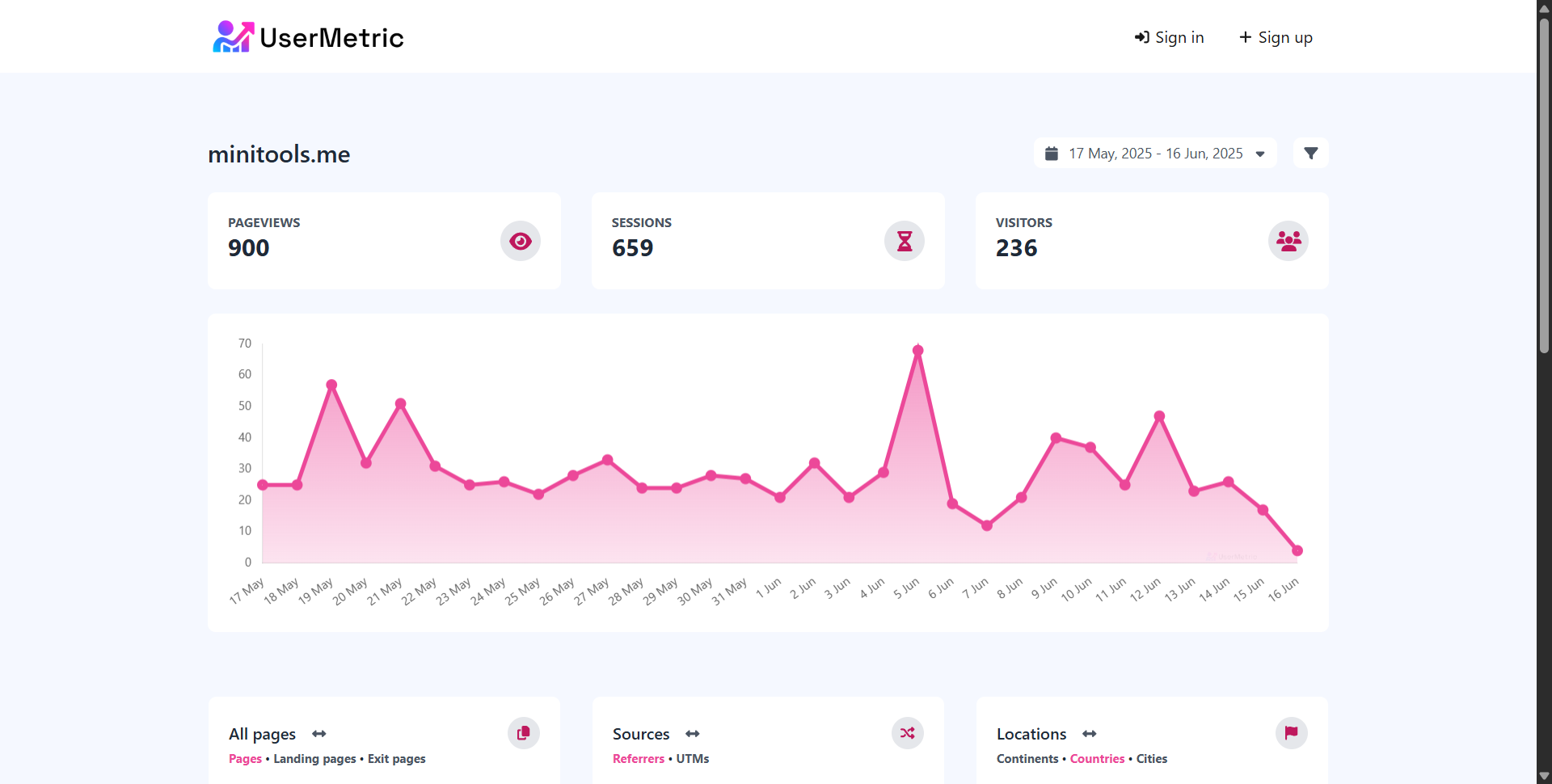
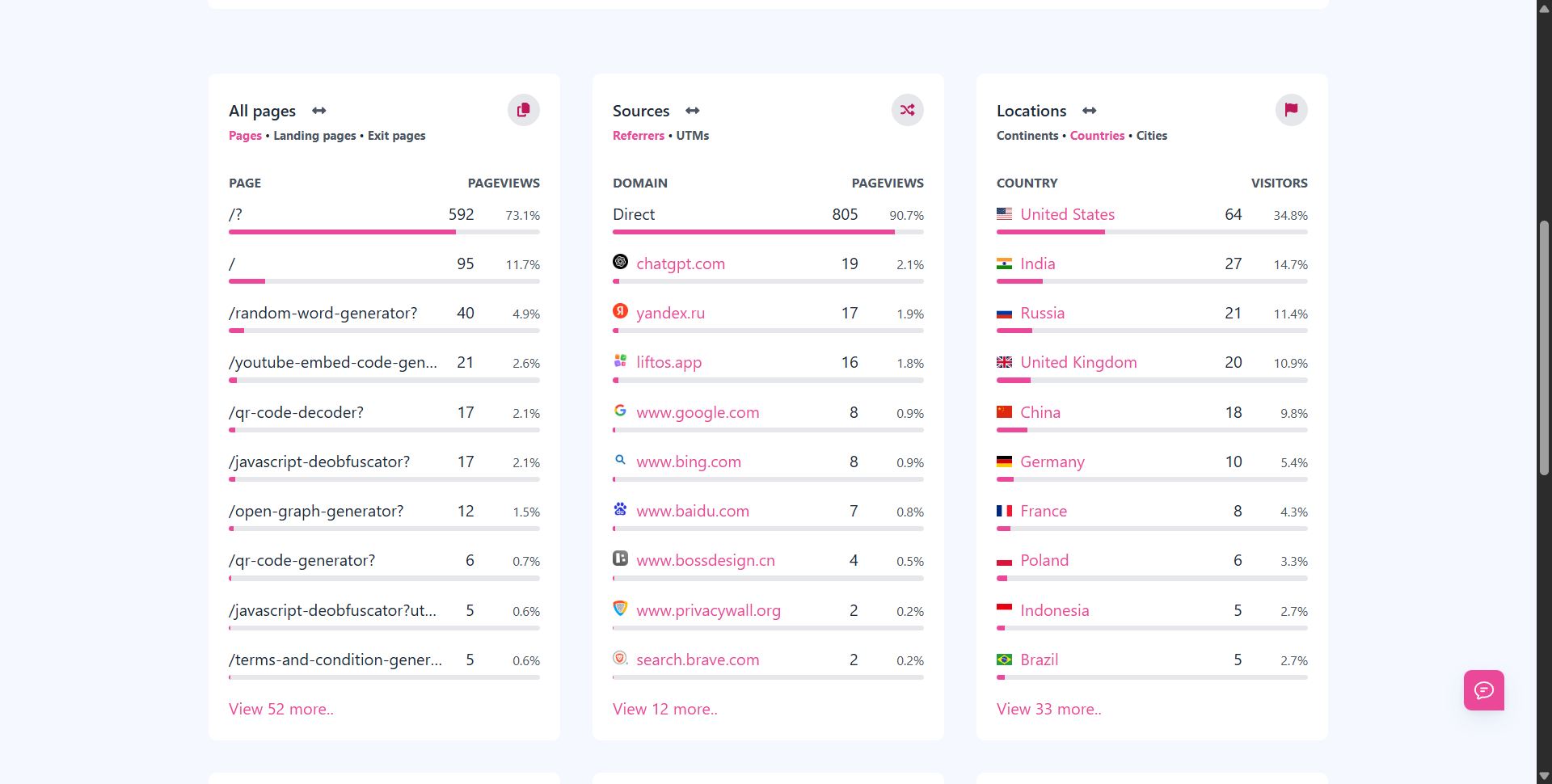
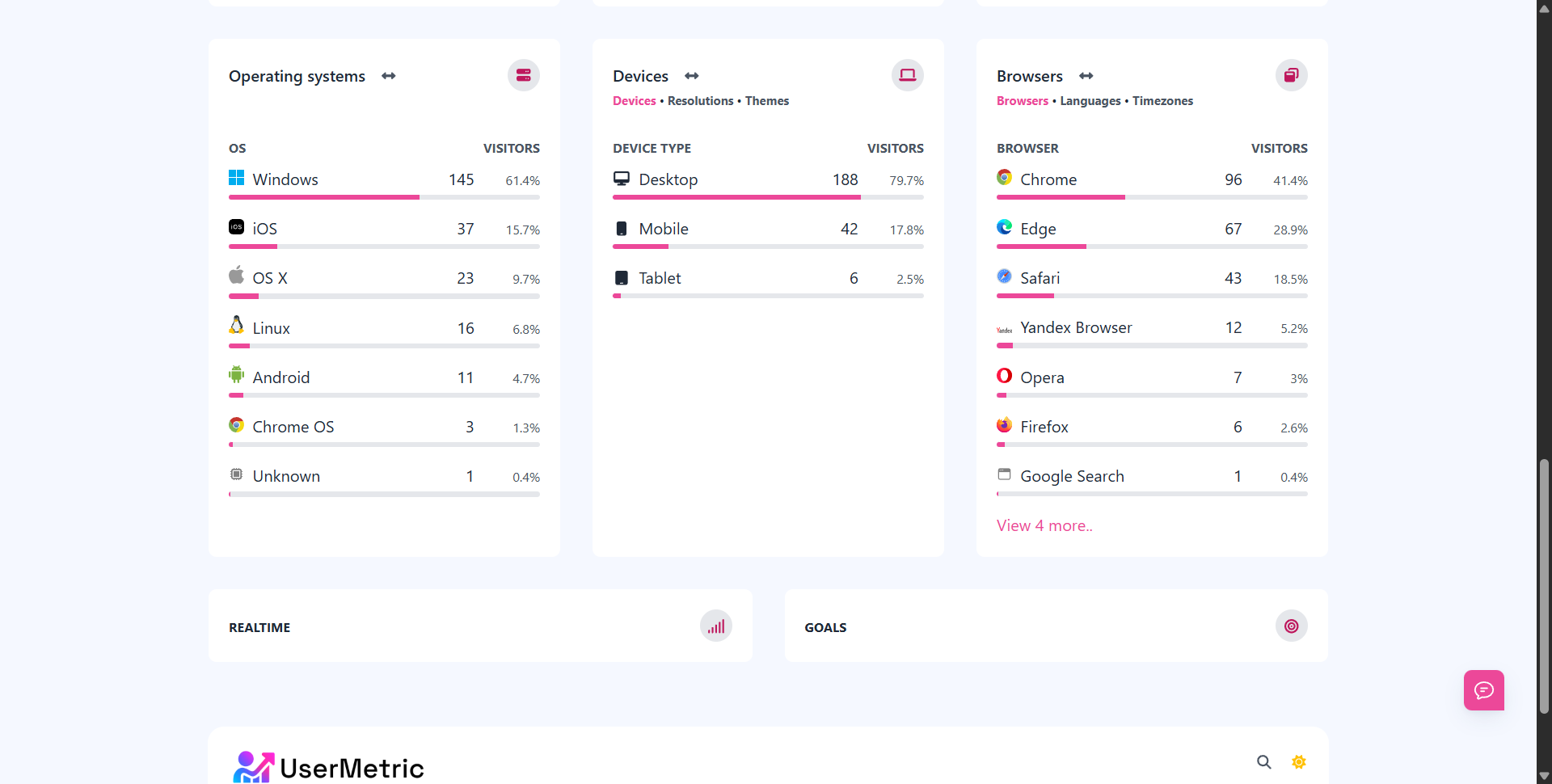
🛡️ No cookies, no personal data
Usermetric’s light-weight tracking doesn’t store or use cookies.
It also avoids collecting IP addresses, device fingerprints, or other personally identifiable information.
This means you don’t need to show annoying cookie banners or manage consent logs.
🚀 Lightweight and blazing fast
Its tracking script weighs only 2.7KB, loading in 50ms–600ms. That’s nearly invisible to the end user and doesn’t slow down your website, a key SEO and UX benefit.
✅ GDPR, CCPA, and PECR compliant
By design, Usermetric meets all major privacy regulations. This saves you from compliance headaches while building trust with your audience.
📊 Core and advanced metrics available
You can still access vital insights like:
- Pageviews, sessions, and referrers
- Landing and exit pages
- UTM tracking
- Device types, OS, browsers, and more
- Goals, and conversion tracking
“With Usermetric, we finally have analytics that respects our users and keeps our team compliant.”
— A SaaS founder in Berlin
Benefits of switching to a privacy focused web analytics tool
Still on the fence?
Here’s what you gain when you make the switch to a privacy-first analytics:
1. Legal peace of mind
You don’t need to worry about user consent, data storage, or international laws. You’re automatically aligned with key regulations.
2. Improved trust and brand image
Visitors are increasingly privacy-aware. Using privacy-first tools builds transparency and earns user trust, especially in the EU.
3. Faster website performance
Traditional analytics can bloat your page load time. Privacy-focused platforms like Usermetric are lightweight and won’t affect your Core Web Vitals.
4. Cleaner, easier-to-use dashboards
Most privacy-first tools remove clutter and focus on essential insights. No more digging through 200 reports to find a bounce rate.
Privacy-focused web analytics breakdown
Within the privacy-focused segment, Matomo leads as the most popular alternative, serving over 1 million websites and representing about 87% of the privacy-focused market.
This makes Matomo responsible for roughly 2.8% of all websites with known traffic analysis tools.
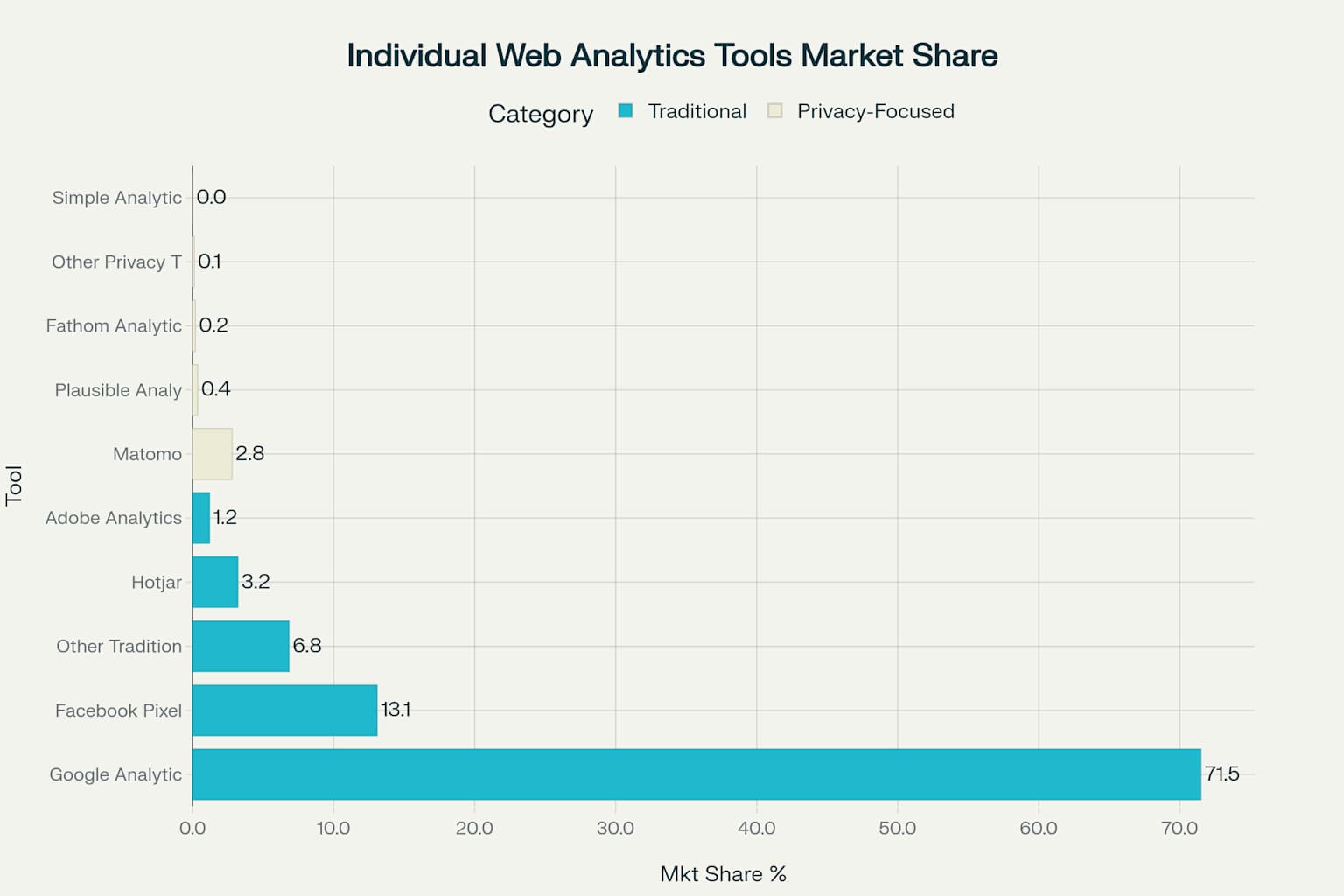
Fathom Analytics
It serves approximately 120,307 live websites, representing about 10.47% of the privacy-focused market.
The service is particularly popular among smaller companies, with 67% of its customers being small businesses with fewer than 50 employees.
Plausible Analytics
It tracks around 28,000 websites and processes over 1 billion page views per month.
Despite its smaller website count, Plausible has gained significant traction with 5,000+ paying subscribers and generates approximately $500,000 in annual recurring revenue.
Simple Analytics
It represents the smallest segment with about 1,100 customers, generating approximately $268,300 in revenue as of 2023.
What features to expect in a privacy focused web analytics platform
A good privacy-focused analytics platform still gives you power without surveillance.
Key features you should expect:
| Feature | Included in Usermetric | Why it matters |
|---|---|---|
| Cookie-free tracking | ✅ Yes | Avoids consent requirements |
| Track goals & conversions | ✅ Yes | Track actions like signups/sales |
| UTM campaign tracking | ✅ Yes | Measure marketing performance |
| Advanced filtering | ✅ Yes | Drill down into visitor behavior |
| Lightweight tracking script | ✅ Yes (2.7KB) | Improves SEO and speed |
| GDPR/CCPA/PECR compliance | ✅ Yes | Avoids legal risks |
| Public or shared dashboards | ✅ Yes | Transparency for stakeholders |
| Bot and spam exclusion | ✅ Yes | Keeps your data clean |
Look for a platform that balances simplicity, compliance, and usability.
Do privacy-first tools affect the accuracy of your data?
Here’s the short answer: not significantly, and in many cases, your data gets cleaner.
The myth of incomplete data
Some think that privacy-first tools mean less reliable insights. In reality:
- Many users block Google Analytics, so you’re already missing data.
- Cookie-based tools can double-count or misattribute sessions.
- Privacy-focused web analytics rely on non-invasive fingerprinting or anonymous sessions, giving 95%+ accurate data.
Usermetric’s example
Usermetric reports 96% accuracy, with near-real-time tracking and 95% uptime.
How privacy-focused web analytics helps bloggers grow without tracking cookies
Bloggers often rely on metrics to understand what content works. But do you really need cookies for that?
Answer: Nope.
What you can still track:
- Which blog posts get the most pageviews
- Time spent on page
- Where readers come from (referrer + country)
- Which posts lead to newsletter signups (via goal tracking)
Example:
Let’s say you wrote a post called “How to Grow Tomatoes Indoors.”
With a privacy-focused tool, you can:
- See it has 1,200 monthly pageviews
- Track that 42 people signed up for your newsletter from that post
- Learn that most readers come from Reddit and Pinterest
- Discover that readers use mostly mobile devices
All of this is legal, anonymous, and ethical.
How to track conversions and goals in privacy-first tools
Yes, you can still measure what matters.
Most cookieless web analytics platforms offer event-based tracking, which lets you monitor user actions without collecting personal data.
Common conversion goals:
- Form submissions
- Newsletter signups
- Button clicks (e.g., “Buy Now”)
- Checkout success pages
- Time on site or page
Tracking goals in Usermetric
Usermetric makes goal tracking simple and flexible:
- Pageview goals trigger when a visitor lands on a specific page, like a thank-you or confirmation page.
- Custom goals require a small script and track actions like external link clicks, form submissions, or button interactions.
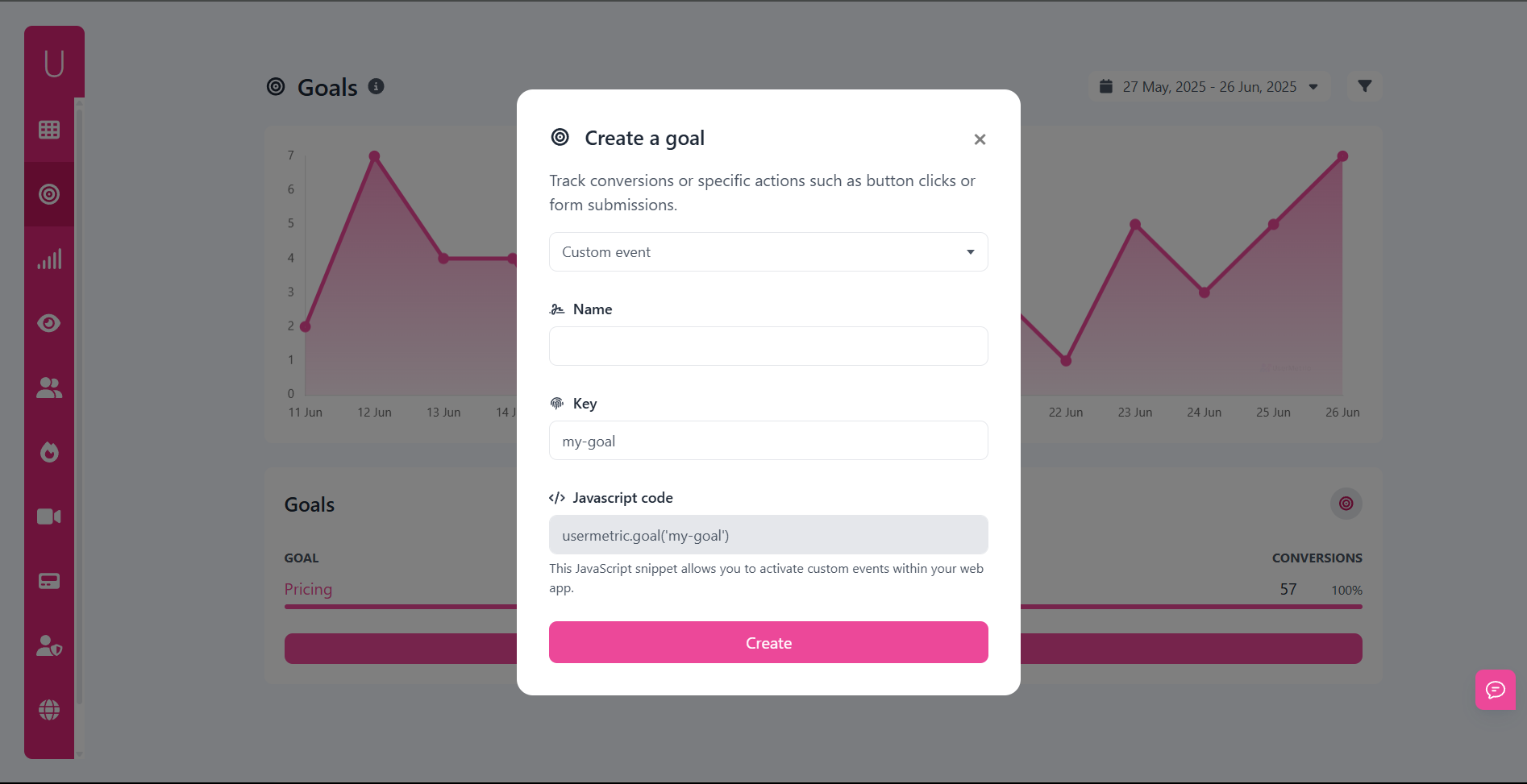
Example for tracking a custom goal:
usermetric.goal('signup-submitted');To trigger it with a button:
<button type="button" onclick="usermetric.goal('signup-submitted')">Sign Up</button>Once added, you can monitor these goals in your dashboard and connect them to UTMs to measure which campaigns drive conversions.
Is privacy-focused web analytics suitable for eCommerce websites?
Absolutely, and in some cases, it’s better than traditional tools.
Why it works for online stores:
- Faster site speed = better SEO = more traffic
- No cookie banner = frictionless shopping experience
- Clean attribution = better ROI tracking
- You still get key insights like top products, traffic sources, device types, and conversions
Example use case:
Let’s say you run a WooCommerce store selling eco-friendly products.
With Usermetric, you can:
- Track UTM campaigns for your Facebook and email traffic
- Set conversion goals for purchases or cart completions
- View product pages with the highest drop-off
- Know which devices your shoppers use
And all this is done without cookies, fingerprinting, or personal data collection.
Installing privacy-focused analytics on WordPress
If you’re using WordPress, setting up a tool like Usermetric is quick and easy.
Step-by-step guide:
- Sign up for Usermetric and copy your tracking script.
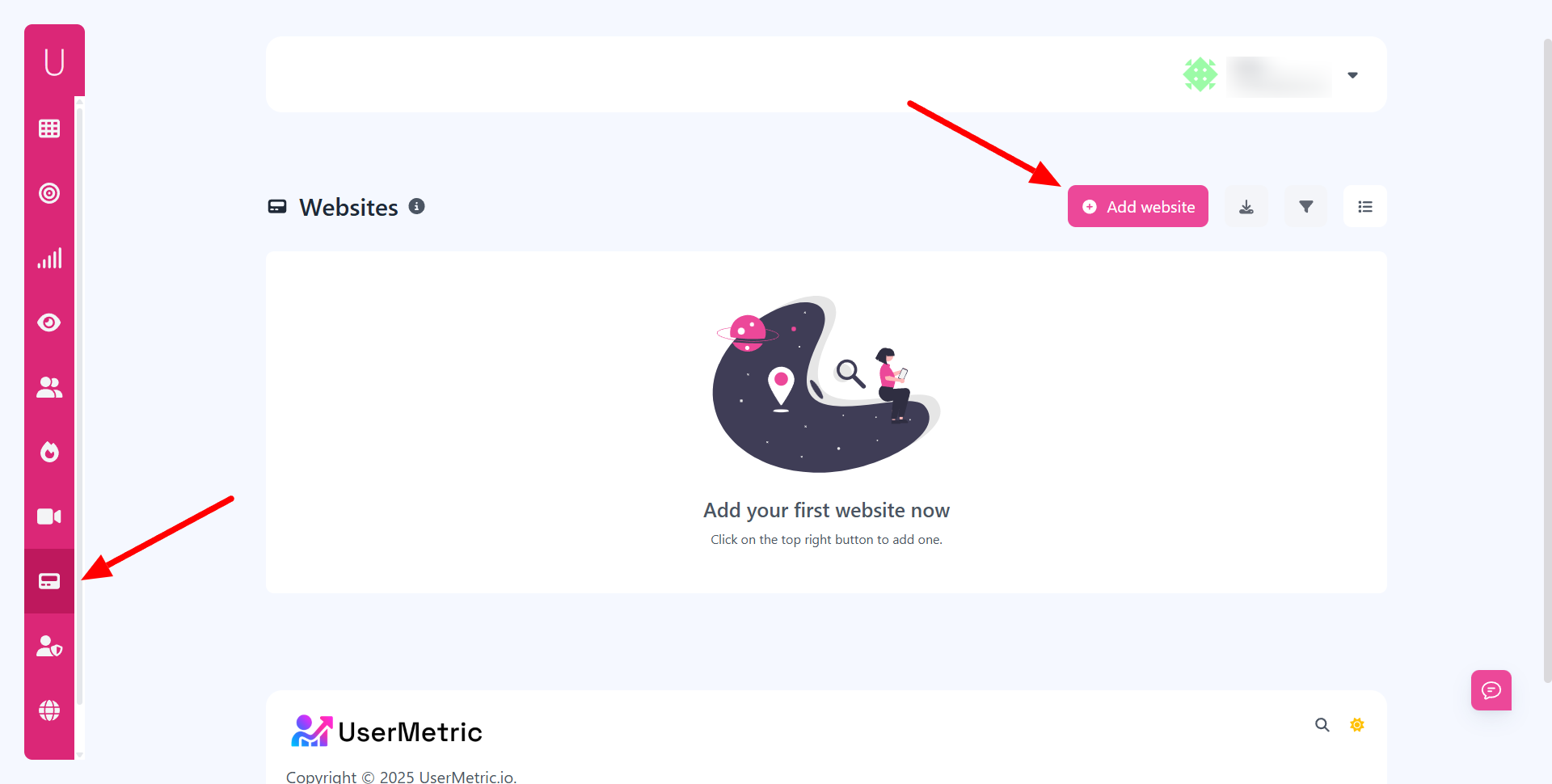
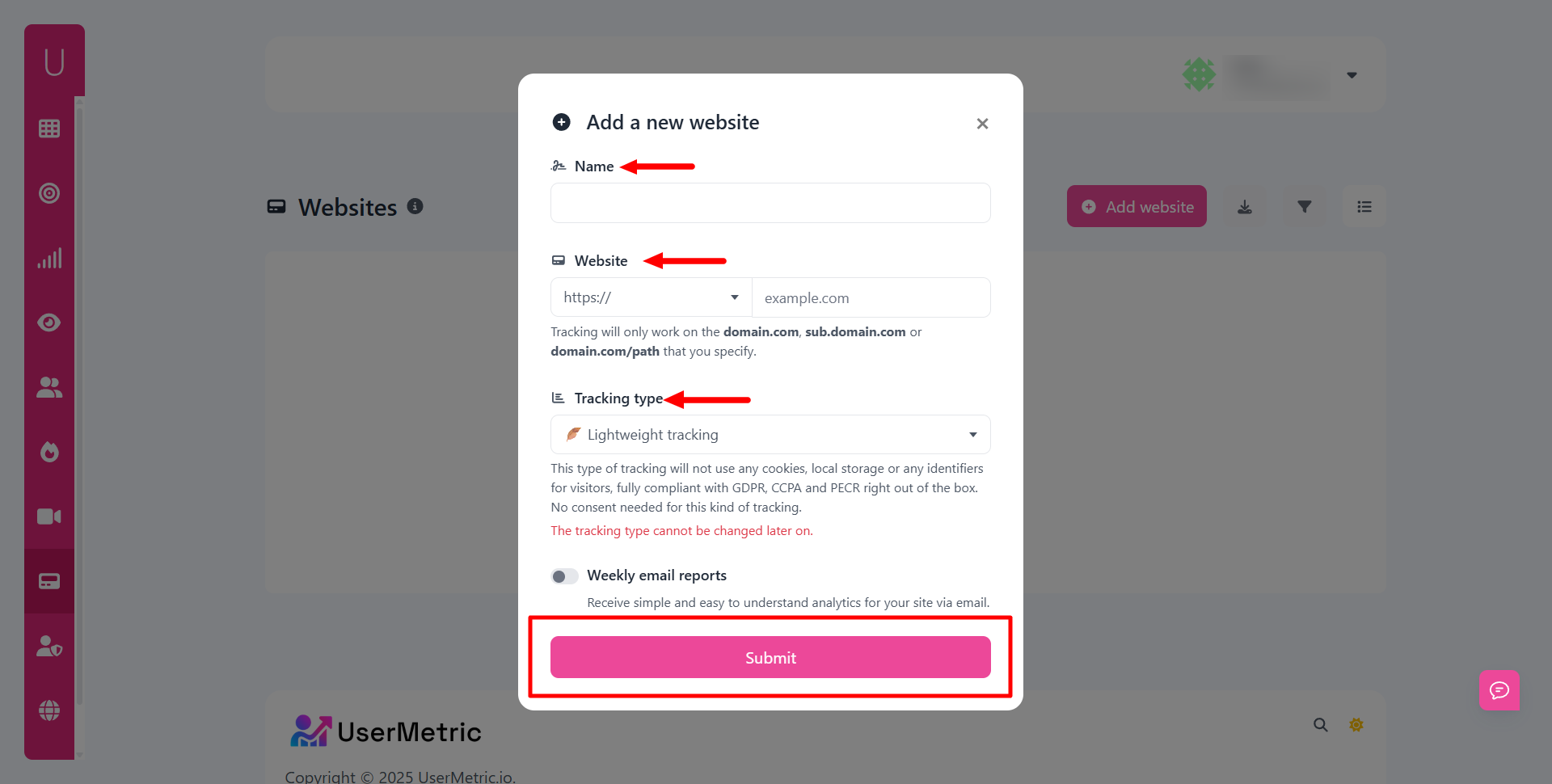
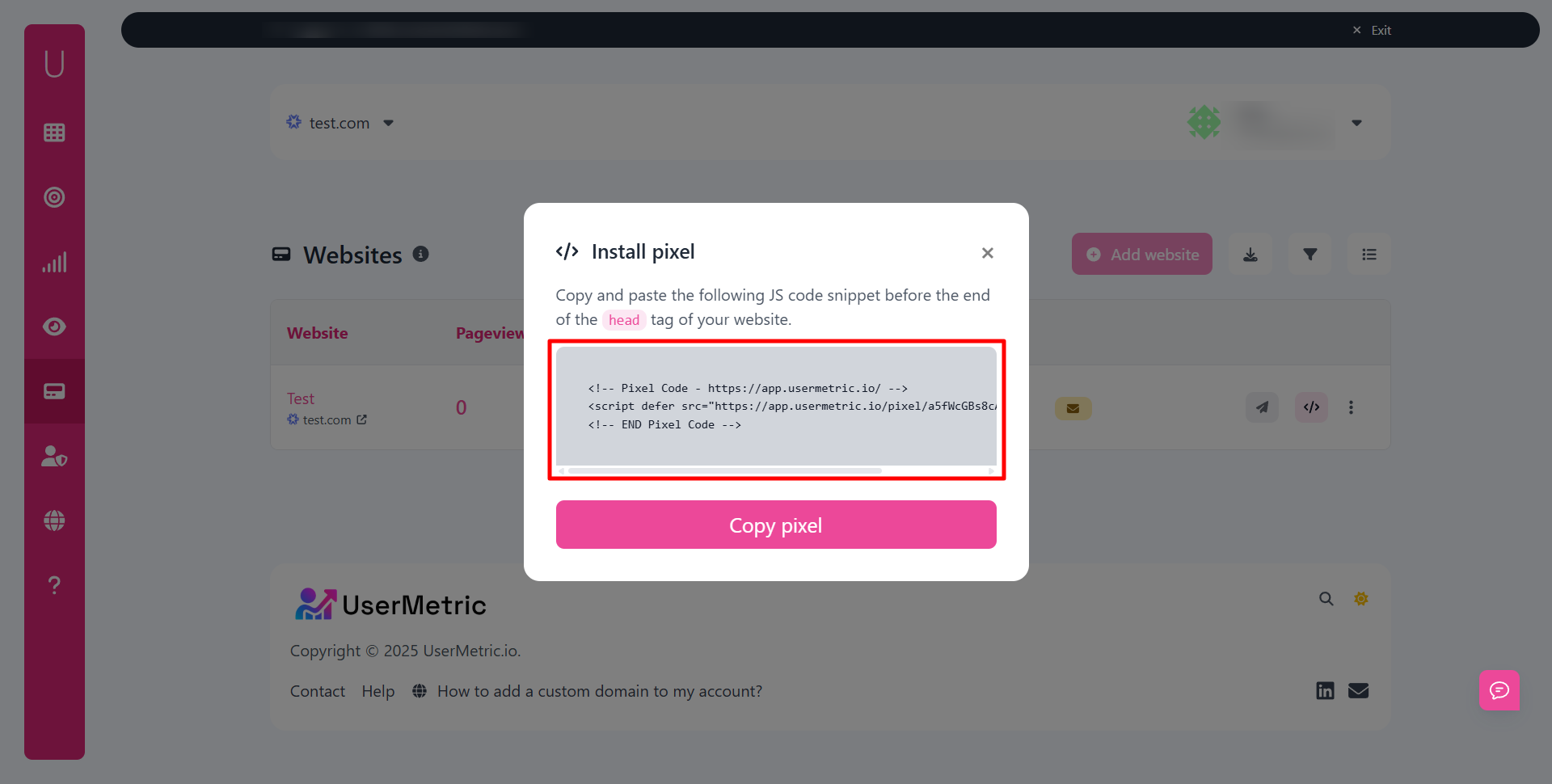
- Install a plugin like Insert Headers and Footers, or add the script directly to your theme’s
<head>. - Save and publish. That’s it, you’re live.
- (Optional) Set up goals to track custom events, or UTMs for deeper insights.
Bonus tips:
- Keep your privacy policy updated to reflect that you use cookie-free analytics.
- Disable any other analytics plugins to avoid duplicate tracking.
Final Thoughts
Privacy-focused web analytics isn’t a downgrade, it’s an upgrade.
You’re not sacrificing clarity. You’re choosing ethical, sustainable growth.
In today’s landscape, your visitors are more informed, and your business is more accountable.
Whether you’re a digital marketer, a small business, a WordPress blogger, or a SaaS founder, there’s a better way to analyze traffic:
✔️ No cookies
✔️ No fingerprinting
✔️ No legal risk
✔️ Full control
And platforms like Usermetric are leading the charge. Offering power, performance, and peace of mind in one privacy-first package.
FAQs
Can I still see real-time data in privacy-first tools?
Yes! Tools like Usermetric provide near real-time dashboards, including live visitor data, without compromising privacy.
Do I still need a cookie banner with privacy-first analytics?
No. Since privacy-first platforms don’t collect personal data or use cookies, you can skip cookie banners (unless other tools on your site require them).
Are there free plans available?
Yes. Usermetric offers a free plan for small websites. You can upgrade as you grow.
What’s the accuracy compared to Google Analytics?
Usermetric and similar tools report 95–96%+ accuracy, often matching or beating Google Analytics, especially since many users block GA scripts.
Can I track ecommerce conversions?
Yes. You can track product views, add-to-carts, checkouts, and successful sales—all using anonymous events and goal tracking.
How do I migrate from Google Analytics?
To migrate from Google Analytics, just remove the GA script, add the Usermetric script, update your privacy policy, and optionally set up UTMs and goals—no database migrations or complex setup required.

